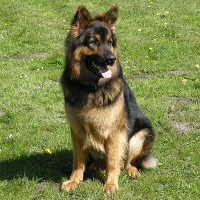 |
Shug |
|
He is not recognized by the F.C.I. |
Origin |
Germany <> China -> U.S.A. | |
Translation |
Francis Vandersteen |
A brief presentation of the Shug |
| The Shug is a hybrid breed. Its parents are the German Shepherd and the Pug. It's a medium-sized, low-maintenance dog. He's easy to train, listens well to commands and is eager to please his master. They need plenty of regular exercise. He is friendly to children of all ages and to other dogs. With good socialization, he can accept other types of pets. He's full of energy, and is known to be playful and affectionate. He'll be happiest in a home with a fenced-in play area, but he'll also be content to stay in an apartment provided he's given plenty of opportunity to get active. |
History of the Shug |
| The Shug is a rare hybrid breed. To understand its origins, it's best to study the history of its parent breeds. |
A little of the German Shepherd |
||
| The origins of the German Shepherd date back to 1899, when Captain Max von Stephanitz decided to breed the various shepherd dogs of Germany into a distinct breed. Stephanitz traveled all over Germany observing the dogs at dog shows, and also studied British breeding methods. In 1899, Stephanitz found what he thought was the perfect dog; he described it as wolf-like. Stephanitz immediately bought the dog and began breeding it with various German Shepherd dogs. Although the practice of shepherding was disappearing in Germany, Stephanitz continued to breed a working dog. When sheep guarding was no longer an option, he introduced the dog to the police and army. The German government eventually adopted the breed for military service. Interestingly, during the Second World War, some American soldiers managed to obtain German Shepherd puppies and brought them back to the U.S. at the end of the war. | ||
 |
||
| Standard of the German Shepherd |
A little of the Pug |
| The Pug originated in the Orient. Experts believe it is distantly related to the Tibetan Mastiff. The Pug was beloved by royalty, and legend has it that Pugs belonging to the royal family were guarded by soldiers. In the 1500s and 1600s, the Chinese began trading with Europeans. It is thought that this is how the Pug came out of the Orient. European royalty fell in love with these cheerful little dogs. In fact, William of Orange credits a Pug with saving his life by warning him that strangers - Spaniards - were approaching. William of Orange honored the Pug by naming it the official dog of the House of Orange. Marie-Antionette owned a Pug before her marriage to Louis XVI, and Joséphine Bonaparte also owned one. The Pug arrived in America after the Civil War. The American Kennel Club recognized the Pug in 1885. |
 |
| Standard of the Pug |
Appearance of the Shug |
| The Shug will look very much like a large Pug. Its coat is short and straight. It may be rough like that of the German Shepherd's parent breed. It will probably be fawn or cream in color, but if its parents are both black, it may also be dark. It may even be brindle. It may have the brachycephalic muzzle of the Pug's parent breed. It will probably have the curly tail of the Pug, with the tail curling over its back. It is likely to appear stocky, even chubby. His chest is deep and broad. He may or may not have white markings on his chest and belly. He will probably have a black muzzle and most of his nose will also be black. |
Temperament of the Shug |
| The Shug is a happy, energetic dog. It is highly intelligent and easy to train. Housetraining may prove more difficult than obedience training. This can be attributed to the Pug's parent breed, which is known to be stubborn at times. Pugs are playful and generally happy to greet strangers. He is kind to children of all ages, but you should be aware that he will need early socialization to learn how to behave with other dogs and pets. He is rarely aloof, although the German Shepherd's parent breed is often aloof with strangers. He's happy in an apartment, provided he gets enough exercise. He loves his family and is also very loyal. |
Needs and activities of the Shug |
| The Shug is a fairly active dog. He'll enjoy short, brisk walks around the neighborhood with you. However, bear in mind that he may inherit the brachycephalic snout of the Pug's parent breed; if so, you'll need to prevent him from overexerting himself, as this could lead to breathing difficulties. Keep a bottle of water handy, especially in hot weather. He'll also appreciate outings to the dog park. If you decide to let him exercise in a fenced-in area, make sure the fence goes deep into the ground. German Shepherds tend to dig their way out of fences. Keep chew toys and toys that stimulate his mind indoors for days when he can't get out to play and exercise. |
Maintenance of the Shug |
| The Shug will probably need little maintenance. His coat is generally short and he sheds very little. Brush him weekly to remove unwanted hair. Brush his teeth two or three times a week to prevent tartar build-up and bad breath, or even better, brush him every day to prevent tooth decay. Wipe his ears with moist absorbent cotton once a week. Make sure there's no redness or odor, as this is a sign of infection. Trim his nails every two weeks, unless he wears them down naturally. It's essential to avoid nail cracks and tears, as they can be painful and even become infected if dirt accumulates. |






 English (United Kingdom)
English (United Kingdom)